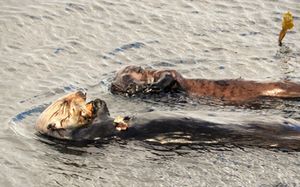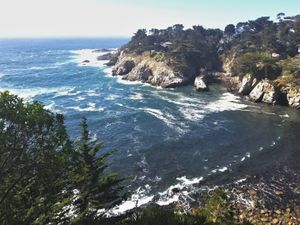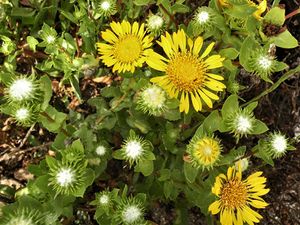Wildcat Cove
Published: November 26, 2018
Author: C Michael Hogan
Topic Editor:
| Topics: | Biogeography (main) |
Wildcat Cove is a rocky embayment with steep cliffs, which comprises a portion of the Central California Coast of the Pacific Ocean in Monterey Bay. The general location is within the Carmel Highlands, an unincorporated portion of the county slightly south of the village of Carmel-by-the-Sea, California. This cove is notable for its complex marine and terrestrial ecosystem, particularly due to its support for a resident colony of the Endangered Southern Sea Otter and other biotic communities. (1,2) Wildcat Cove is an element of a Federally Designated Marine Sanctuary, which is the largest marine sanctuary in the Continental USA, and also an element of the largest kelp forest in North America.
Contents
Geology
Wildcat Cove is situated along the western coastal slope of the Santa Lucia Mountains, a range that extends from Carmel Valley to the northern end of San Luis Obispo County. This block comprises rugged terrain with a very complex content of strata and faults. The Salinian Block forms the basement under Wildcat Cove and most of the northern Santa Lucia Range; this basement rock dates to 130 million years before present. This basement formation consists of granitic and metamorphic material. Both crystalline based rocks were produced by high temperatures and low pressure. Chief metamorphics are marble, gneiss and amphibolite, while main granitics are bonalite, granodiorite and quartz diorite. (3)
Climate
Regional climate is characterized by a cool wet winter and a low precipitation mild Mediterranean type summer, punctuated by considerable morning fog days.(3) Rains usually commence in October, with the larger storm events transpiring until year end, but often enduring until mid April. Storm fronts typically enter from the south; however heaviest precipitation prevails at the crest of the coastal ridges several miles inland. Snowfall may rarely occur in winter somewhat inland on the highest elevations of the ridge of the Santa Lucia range. Mid April through June is demarcated by clear weather and onshore wind. The summer season is cool and foggy along the lower coastal slopes and drainages.
In terms of climate history the Holocene era, particularly 8500 to 5500 years before present, resulted in a steady warming. The Medieval Warming Period has been defined by oxygen isotope profiles, that evince clearly warmer ocean temperatures in the period 1000 to 1400 AD.(4)
Flora and Fauna
Wildcat Cove is epitomized by a quite vertical rocky cliff edge plunging to the Pacific Ocean. Shellfish species common to the area include California mussel, various barnacle taxa, chitons, black and brown turban snails, abalone, sea pens, limpets, and sea urchins. Marine fishery resources of the rocky shoreline are dominated by a gamut of over 345 marine fishes, including rockfish, surf perch, cabezon and lingcod. Marine mammals present include Southern sea otter, Common seal, California sea lion, Steller sea lion, Northern elephant seal, Pribilof fur seal, and Southern fur seal. Further offshore are 18 whale species, notably including the annual migrations of the Gray Whale. Kelp beds in Wildcat Cove add to the plethora of marine species supported here, notably providing ideal habitat for the Southern sea otter.
Terrestrially the steep rocky terrain is dominated by Monterey cypress and Monterey Pine with some admixture of Coast live oak. The understory has a rich assemblage of woody shrubs and herbs, including Toyon, Brambles, Dudleya spp. An important early biologist who classified many of the plants in this portion of the coast was Alice Eastwood.
Prehistory
Along the coastal portion of the Santa Lucia Range, 79 prehistoric sites have been identified, four of which are in the local area to Wildcat Cove within the Soberanes Quadrangle. For artifact security reasons these sites are not publicly identified. These habitation sites are generally shell midden deposits comprising flaked-stone tools, crafted beads, debitage, ground-stone as well as fire-cracked rock.
The main tribes known to inhabit the vicinity of Wildcat Cove are Ohlone and Rumsen, whose range included the Monterey Peninsula, the lower Carmel River valley and the coastal area south to the Soberanes Creek watershed.(5) Remains of four ancient villages have been found on this section of the coastal zone, but exact locations have been obscured in public reports to protect artifacts. Typical Ohlone and Rumsen villages along the coast are thought to have consisted of 25 to 60 people, although the tribal mix in this area is thought to be more fluid than in other California regions; hence, the local tribes could have been a mixture, for example, of Rumsen, Ohlone and Sarbentaruc, a tribe whose northern locus is opined to be somewhat south of Wildcat Cove northerly of Notleys Landing.
Earliest Native American presence documented by archaeologists is the Millingstone Period (4400 to 3500 BC). Millingstone phase is characterized by excavation of handstones, milling-slabs, lanceolate points, and Olivella gastropod beads. Point types and ground stone assemblages correspond with the Oak Grove Culture in the Santa Barbara region. Millingstone period extends throughout the California Central Coast and is noted by exploitation of shellfish, particularly mussel, along with marine and terrestrial mammals.(6) Millingstone coastal sites are deemed to have been seasonal and likely confined to autumn and winter.
In the Early Period (3500 to 600 BC) The local use arrived of Contracting-stemmed, Square-stemmed, and large Side-notched projectile points, along with mortars and pestles. Hand-stones and Milling-slabs continued to dominate the ground stone assemblage. Fishing artifacts became more numerous, notably notched net sinking pieces and gorge fish-hooks. Faunal remains evince that fish and terrestrial mammals became more prominent in the tribal diet.
The Middle Period: Willow Creek Phase (600 BC to 1000 AD) is defined via examination of artifacts recovered from one of the Willow Creek sites (CA-MNT-282). The phase is epitomized by sizeable stemmed points; introduction of circular shaped fish-hooks made of mussel and abalone; and continuing use of mortars, pestles, milling-slabs, and hand-stones. Olivella shell saucer objects are also present in this phase. The period brings increased marine fishing, as well as enhanced hunting of rabbit and otter. Inter-regional trade is indicated by presence of large quantities of obsidian from the interior.(7)
The Middle/Late Transition or Highland Phase (1000 to 1300 AD) is depicted in large stemmed projectile points and ground-stone assemblage; moreover, the hopper mortar appears during this phase. Medium-size ground and perforated serpentine discs, which likely served as fishing net weights also appear. Bead types include Olivella Barrel, Tiny Saucer and Regular Saucer styles; also diagnostic of the Late Transition are large end-ground and cupped beads. Faunal remains indicate appearance of sizable anchovy harvesting, a precursor of the overfishing of Monterey Bay by Europeans in the nineteenth century. Obsidian traces declined, indicating decline of long range interior trading.
Ethnobotany
There is a disproportionate representation of coastal herbs that are used medicinally by Native American peoples who have lived and continue ro live in Monterey County; this fact underscores the factual basis that the coastal Monterey Bay area has been a center for health and wellness for millennia, well before arrival of Europeans.
Ohlone and Rumsen peoples utilized a variety of herbal remedies for treatment of skin, and internal medical issues. For example the prevalent Poison Oak rash is addressed by California Bay, Gumweed and Coffeeberry plants, all of which are found in the Wildcat Cove area and more broadly in the Monterey Bay and Central Coast areas.(8) Ohlone use fronds of Birdsfoot fern as a wash to treat facial sores; they also decoct leaves of Bush Monkey Flower, Vinegar weed and California goldenrod for addressing sores and wounds on the face; California wild rose cooked hips are applied to scabs ; furthermore, Yerba Mansa as well as Monterey Indian Paintbrush, Angelica, Yerba Santa and Figwort are applied as skin healing remedies.
Hair and scalp treatments of the Ohlone include native Marah seed, Beeswax, Bracken fern, Seep willow and California poppy. Wild ginger is used widely by Central coast tribes as a gum and toothache remedy as well as a poultice for ills; this plant is not recommended for internal use. White sage (Sa;voa a[oama), which grows robustly at clifftop above Wildcat Cove, is used for sore throat treatment and to instill a feeling of well being and calmness.(9)
History
Sebastian Vizcaino mapped the California coast in this region in 1602 AD, as he praised the virtues of Monterey and Carmel Bays. Spain did not begin to colonize this rugged area until 1779, when Gaspar de Portola was dispatched for an overland expedition to establish a settlement at Monterey Bay, thereby establishing Spain's claim to the region. Since 1741 Russian fur hunters settled the northern California coast, with emphasis upon control north of the Golden Gate. Portola ventured inland only in proximity to the Pacific Ocean shoreline in his march northward, until the party encountered the ocean cliffs of the Santa Lucias looming over San Carpoforo Creek discharging to the Pacific.
Subsequent to the secularization of the Spanish mission system in 1833, two government land grants were made in the coastal territory between the Carmel River and Point Sur: Rancho del Sur, granted to Juan B. Alvarado; and Rancho San Jose y Sur Chiquito, to Teodoro Gonzales; the northernmost of these grants encompassed Wildcat Cove.
Wildcat Creek Bridge was constructed as part of California State Highway One in its present form in the year 1933; the CALTRANS designation of this structure across Wildcat Creek is No. 44-16. Bridge construction crews in the year 1933 were the first people to notice the rediscovery of the Southern Sea Otter (Enhydra lutris nereis), which species was thought to have been extinct for decades prior.
Art and filmography
In more modern times, Wildcat Cove has been an epicenter for the arts and film. William Ritschel, a noted early California artist, purchased land on the northern oceanfront of the cove and built a home here in the early twentieth century. Purportedly some of his original works are hung in that historic home. John O Shea was another noted Early California artist who lived above Wildcat Cove. Ritschel and O Shea were among the first artists to chose to live in the wilderness of Carmel Highlands rather than the village of Carmel.
The following image shows the cove northern headland as viewed from the ocean https://pat-hathaway.pixels.com/featured/carmel-highlands-monterey-california-circa-1918-california-views-archives-mr-pat-hathaway-archives.html
In the early nineteen thirties noted photographer build a cabin and studio on Wildcat Hill along the north canyon edge of Wildcat Hill. In present times Edward Weston s grandson Kim inhabits the home with wife Gina ; Kim Weston is a noted present day photographer, who has retained the original architecture of the home and studio.
In the late twentieth century the 1971 Clint Eastwood film "Play Misty for Me" was filmed in large part at Wildcat Cove as well as nearby parts of the Monterey coast; the film co-starred Donna Mills and Jessica Walter, and represented the directing debut of eastwood. The home in which the film was made listed for $11.9 million.
The 1992 film "Basic Instinct" was filmed prominently at Wildcat Cove, with landscapes of the cove in many scene backdrops. Starring in the film were Sharon Stone, Michael Douglas and Jeanne Tripplehorn.
In 2017 and 2018 much of the HBO television series Big Little Lies was filmed at locations along Wildcat Cove; the series stars Nicole Kidman and Reese Witherspoon.
References
- Applied Marine Sciences. 2001. Quality Assurance Program Plan for Central Coast Long-term Environmental Assessment Network, pp. 46. Central Coast Long-term Environmental Assessment Network, Santa Cruz, CA
- California Regional Water Quality Control Board and Duke Energy .2001. Central Coast Long Term Environmental Assessment Network 2001 Annual Report http://www.cclean.org/wp-content/uploads/2014/07/Annual_Report_2001.pdf
- Patricia Mikkelsen, Laura Leach-Palm, Valerie Levulett, Robert Pavlik, Randall Milliken, Jennifer Hatch, Elizabeth Kallenbach, and Jerome King. 2001. Cultural Resources Inventory of CALTRANS District 5 Rural Highways Monterey and San Luis Obispo Counties, California: Coast Highway
- M. A. Glassow, L. R. Wilcoxon and J. Erlandson .1988. Cultural and Environmental Change During the Early Period of Santa Barbara Channel Prehistory. In The Archaeology of Hunter-Gatherer Subsistence Economies in Coastal Environments, edited by G. Parkington and G. Bailey. Cambridge University Press, Cambridge.
- R. Milliken .1987. Ethnohistory of the Rumsen. Papers in Northern California Anthropology 2. Northern California Anthropological Group. Berkeley, CA
- C. Michael Hogan. 2008. Morro Creek. The Megalithic Portal. Ed. Andy Burnham
- T. Jones .1995. Transitions in Prehistoric Diet, Mobility, Exchange, and Social Organization along California's Big Sur Coast. PhD. dissertation, Department of Anthropology, University of California, Davis. University Microfilms, Ann Arbor.
- C. Smith. 1999. Ohlone Medicine. Cabrillo College, Aptos, California
- Sara Reid, Van Wishingrad, and Stephen McCabe 2009. Native American Uses of Plants: Ethnobotany. University of California Santa Cruz Arboretum
Citation
C. Michael Hogan (2018) Wildcat Cove. Encyclopedia of Earth. National Council for Science and Environment. Washington DC.


